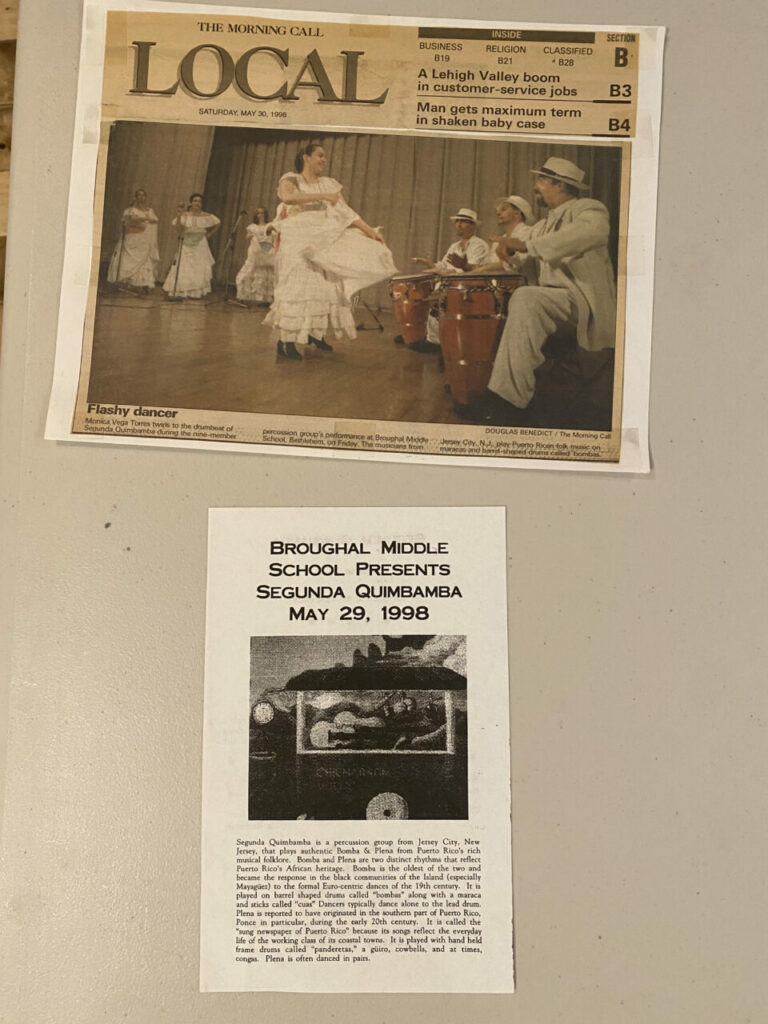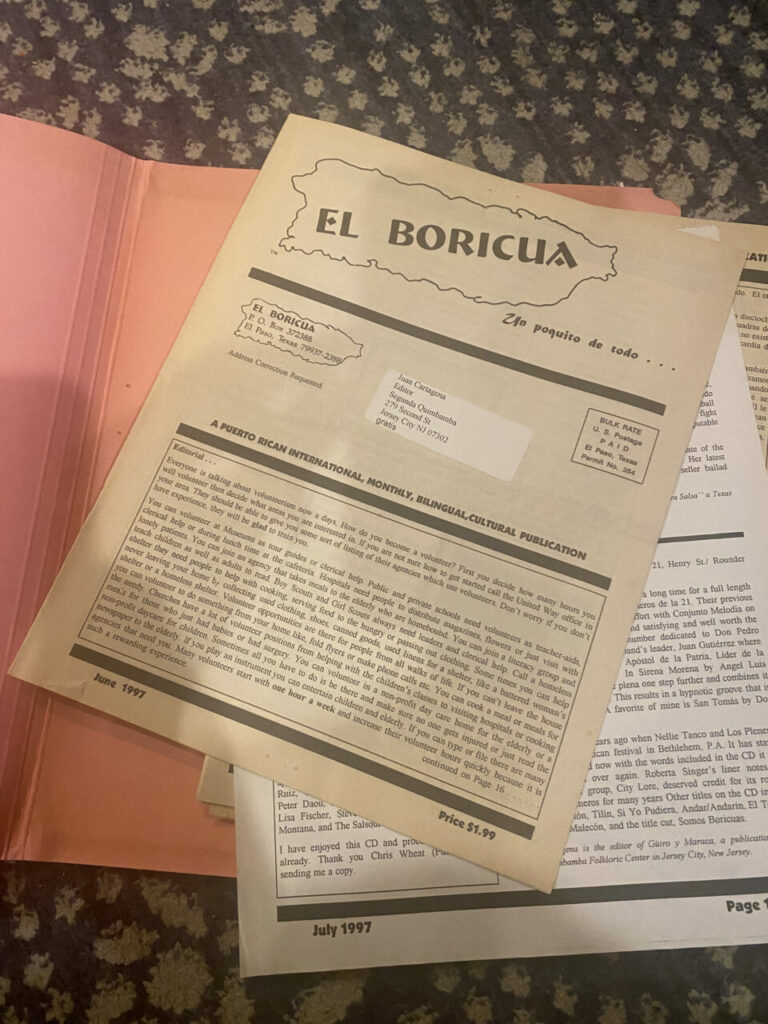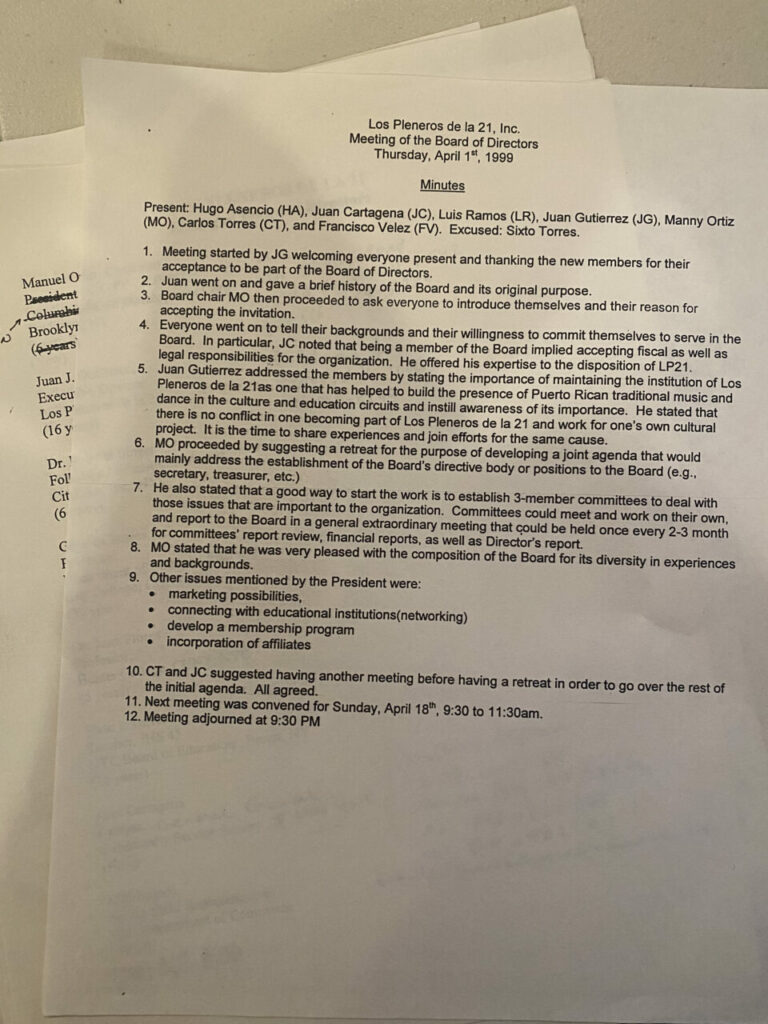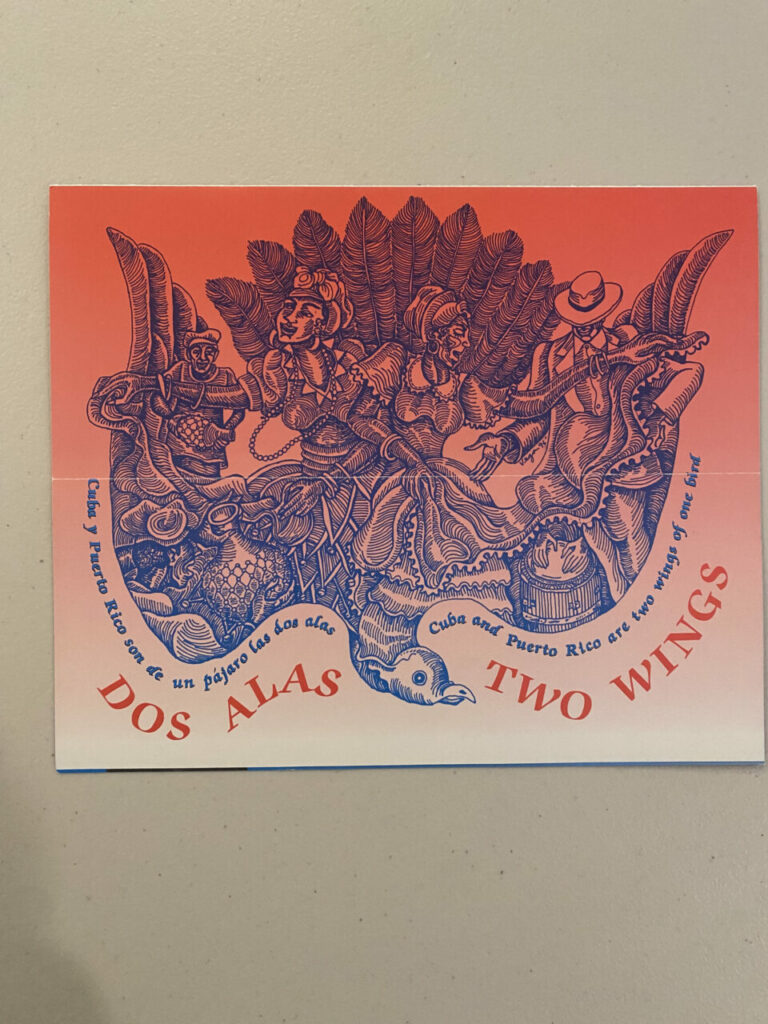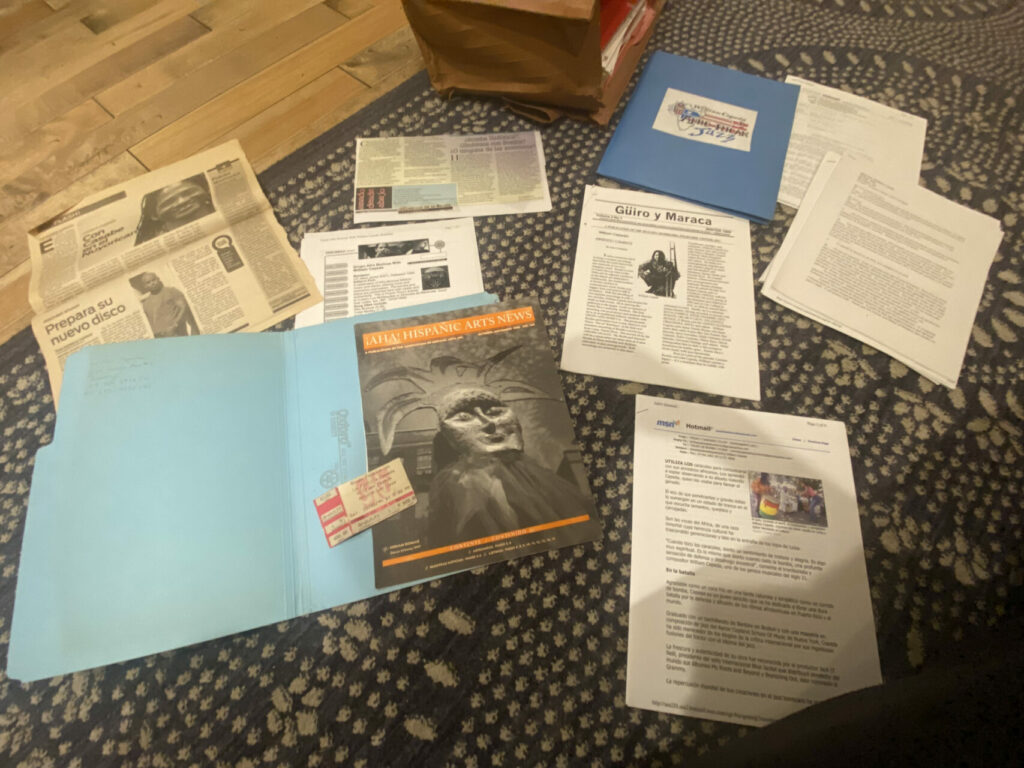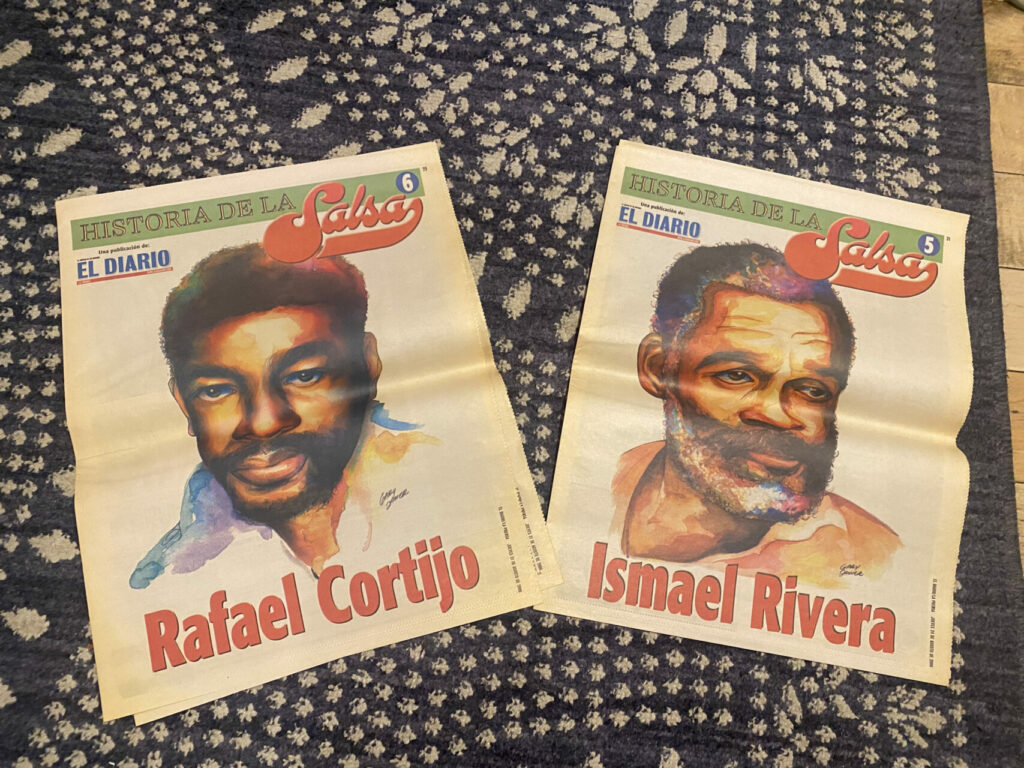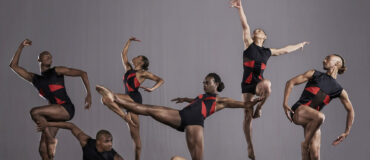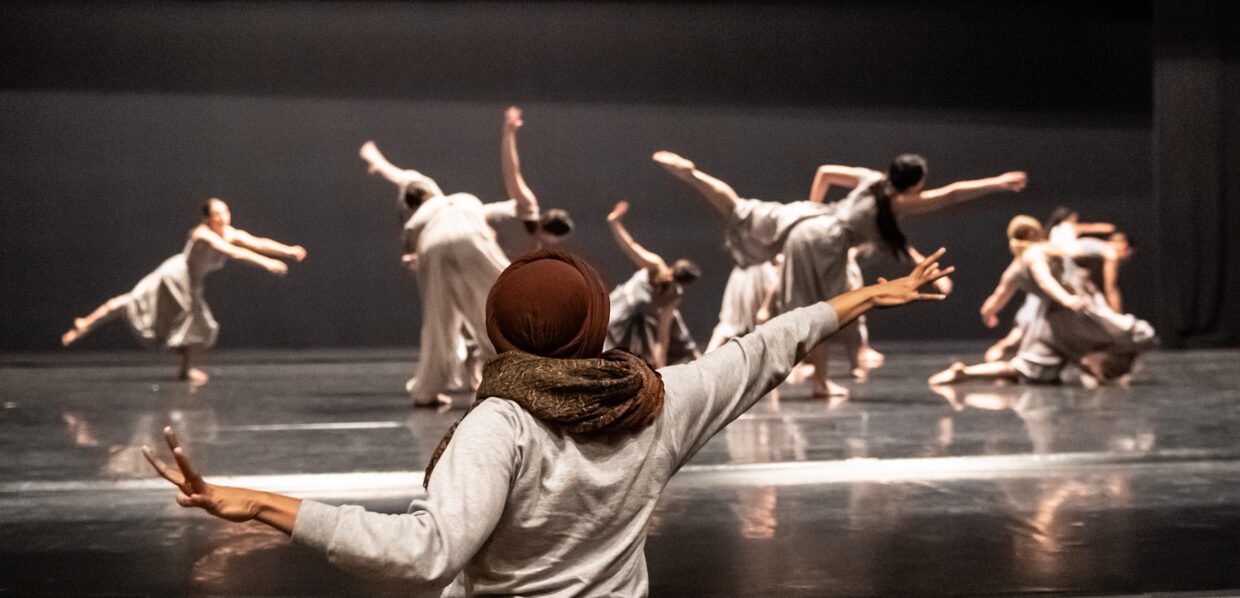Archiving Fellowships Blog: Segunda Quimbamba Folkloric Center, Part 2
By Abdiel Jacobsen
Abdiel Jacobsen is a 2023 Archiving and Preservation Fellow with Segunda Quimbamba Folkloric Center. Read more about the Fellowships here. This is the second part of Abdiel’s blog; read the first part here and the third part here.
Taking Inventory
When beginning the inventory for Segunda Quimbamba Folkloric Center (SQFC), we started by first reviewing the “Artist’s Legacy Toolkit” resource on Dance/USA’s website–a resource that proved to be helpful throughout the duration of the inventory process. We began with identifying archival formats SQFC had in their possession:
Artifacts – costumes, artwork, awards, instruments.
I discerned that instruments would be an essential artifact unlisted on the inventory template provided by Dance/USA, being that the dance and drumming tradition of Bomba is rooted in live musical interplay. Most artifacts are owned by the founders, Juan Cartagena and Nanette Hernandez, and not currently reserved for the non-profit entity SQFC, although we are in ongoing discussion on which items should potentially be set aside for SQFC’s archive. Live instruments are present and played at every performance, batey or bombazo (akin to jam sessions) and thus are important to preserve. Juan Cartagena mentioned it takes over three months to make a barril (Bomba drum) by hand and is quite a tedious and laborious process. To make your own drum is a rite of passage in becoming a skilled Bomba drummer.
Their dance company 2Q also uses traditional garments such as the voluminous Bomba circle skirts, enagua (slip), colorful headwraps, and waist bands traditionally worn by women and white pants, button-down shirts, and a hat traditionally worn by men. Nanette explained that for women, there is a difference between costumes in Bomba and Plena and one of the main differences is length. Bomba costumes are longer than Plena costumes. Bomba costumes are also typically worn with an enagua underneath. Dancers will compete for who has the most beautifully decorated enagua, which are frequently made with colorful bow ties.
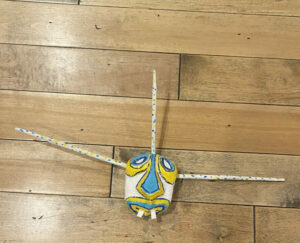
Picture of Vejigante created by one of the children in their educational program
There are also several vejigante masks and pictures of vejigante masks mounted on the walls at SQFC. Vejigantes are folkloric masks used in parades, festivals, and celebrations, particularly at Carnival throughout Puerto Rico, which in the city of Loíza happens at the end of July and in Ponce in February or March tied to the religious calendar of Lent. Vejigantes are made slightly differently depending on the region. In the northern region they are made out of coconut shells and in the southern region they are made of papier-mâché. According to Juan, these colorful masks are used to lead parades in order to ward off evil spirits and symbolize protection. 2Q has used them in parades they’ve performed in in New Jersey and have made their own. Even kids from their educational program learn how to make them.
Audiovisual (AV) Materials – DVDs, cassette tapes, microcassettes, VHS, mini DVs, DATs.
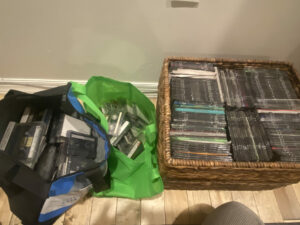
Cassette tapes, CDs, and DVDs.
DVDs and cassette tapes are the AV materials SQFC has the most of. Juan brought two canvas bags of cassette tapes, two brown bins of DVDs–75 cassette tapes, and 320 DVDs. I was overwhelmed at first thinking to myself, how in the world am I going to get all the data of these materials into a document? I began to use Tool 8: Inventory Template from the Artist’s Legacy Toolkit and started converting the excel spreadsheet on SQFC’s iPad to log in the cassette tapes first–the iPad was their preferred device to input information. I googled some of the language on the cassette tapes to ensure correct information was included in the inventory template. The tapes were a bit dusty but in pretty good condition. There was quite a bit of information such as date, title, content, and time stamps notated on the cassettes which helped save time by eliminating the process of listening to the tapes and identifying the content. Thankfully, for the few tapes that did not have any notation on it, Juan was able to recall most of the data requested on the inventory sheet. I was very impressed by his memory! He is no doubt a living archive. I logged 12 cassette tapes the first day which took me about two hours. It took two weeks in total to complete all the tapes. I noticed many of the tapes I pulled out were training sessions that Juan and Nanette attended for educational purposes. These were crucial to their own training and will be a helpful resource to future company members in their own training processes.
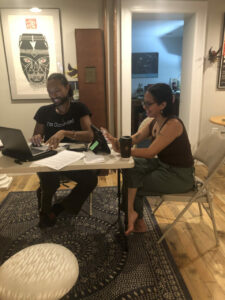
Abdiel (left) with Yawa (right) working on SQFC archive for the first time.
I cultivated a steady flow and felt ready to tackle the DVDs, until I recognized that most of the DVDs did not have much content notated on the casing, unlike the cassette tapes. It was a bit daunting thinking about watching all those materials to gather the content description of each item. I was relieved when Nanette mentioned that they had a drum student, Yawa, who worked in archiving and volunteered to help. Yawa is a cultural worker focused on curatorial work and seed keeping, both of which are disciplines in the nurturing and preserving of history and creativity. They are originally from Ecuador with indigenous roots of the Kichwa people of the Andes region of South America. Yawa is also the founder of MUYU–translated as “seed” in Kichwa–a cultural incubator and marketplace for low income creatives. We were excited to work with Yawa! They helped me with the inventory document by assisting with creating controlled vocabulary, creating word keys, and transferring the excel sheet to a Google spreadsheet so that I could work remotely with them, Juan, and Nanette. When assisting with gathering content for inventory of DVDs, Yawa asked Juan to record his description of the content of the DVD we watched together, which gave me the idea to do that for every DVD–creating an archive of verbal descriptions that the viewer could obtain for added context. This would also help with accessibility for the visually impaired. In fact, I began to ask Juan to give a visual description of each person in the video to provide as much detailed description as possible. However, this proved time consuming–about 10-30 mins per DVD depending on how much content was on each DVD. I ended up leaving this task to be completed by Yawa and/or any other volunteer.
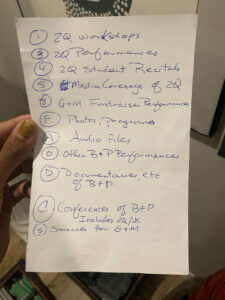
Photo of the key Juan created for CDs, DVDs, and VHSs
Based on Juan and Nanette’s discussion of what SQFC’s legacy centered, I identified three main pillars for their archive: SQFC’s Güiro y Maraca Newsletter, Education/Training, and Performance. Any materials not related we decided would not be relevant for this archive. For example, there were some tapes of music that were preserved but not related to the newsletter, education programs, or any performances of SQFC, so we didn’t log those tapes. Juan created a key to categorize the DVDs, CDs, and VHS tapes. The total amount was 329 items! Later Juan dug up some old DATs and miniDVs which I had never seen or heard of before. DAT stands for Digital Audio Tapes. This format was introduced in the late 80s, is slightly smaller than cassette tapes, is digital rather than analog, and is only recorded on one side. Mini DV stands for mini Digital Video which was introduced in the mid 1990s as a type of digital format that was used for recording, storing, playing and manipulating media recorded through a camcorder and was a convenient solution to storing large amounts of video data digitally in one tiny cassette–much smaller than VHS tape. Technology advanced quite quickly and within less than a decade they went from cutting edge to ordinary–and at this point completely obsolete. At the end, I organized the physical AV items in the categories established by Juan.
Paper materials – photos, slides/negatives, programs, office supplies, press clippings, books, brochures, notes, newspapers, legal documents, promotional materials, educational materials, creative materials.
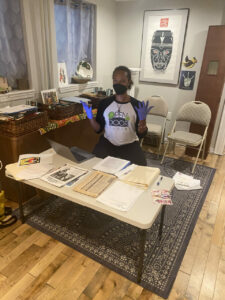
Photo of me handling SQFC’s paper documents with protective gear
When I began identifying the paper materials I reviewed the resources in the Artist’s Legacy Toolkit. I started inventorying with as much data I could get from Juan on each item. The length of paper files measures about 11 feet long. Granted, SQFC only had one file cabinet with four drawers that was already quite well organized, so I didn’t have to organize the physical items like I did for the AV materials. Juan is a constitutional and civil rights attorney and has been a leader in the national legal community much of his 40-year career. His organizational skills are reflected in the archives of SQFC’s paper files. They were in alphabetical order, labeled clearly, and in pretty good condition, although the files were quite dusty. Though generally gloves aren’t recommended for handling paper materials, a tip for those who have allergies to dust like me: wear gloves and a face mask for protection before going into any paper files. You will protect the files from any dirt on your own hands and at the same time you will be protected from any files that may have any dust or residue from getting onto you. I learned the hard way and ended up getting a chest infection from my encounters with the dust, and not wearing any protective gear. I should have known better!
The dust is also a testament to how these files have not been activated for over a decade. Juan and Nanette enjoyed reliving all the memories that came up for them when reopening the files and it is so impressive how much they remember. Here are a few photos of materials that stood out to me:
- An original program of Segunda Quimbamba performing at Nanette’s old middle school. The day after the performance it was reviewed in “The Morning Call” local newspaper of Leigh Valley and Allentown, PA. Nanette’s brother called in sick to work that day to perform with them and got caught because of the newspaper review. We laughed at this memory!
- An original newsletter entitled “El Boricua”– a cultural newsletter of Puerto Rico that reviewed “Güiro y Marca” and its coverage on Bomba and Plena rhythms.
- Juan has done quite a bit of legal and organizational work for the Bomba and Plena community in the diaspora including contract agreements, negotiations, obtaining copyrights, royalties, and travel documents for foreign artists. This is an organizational document of his work as a board member and advisor for the famous Los Pleneros de la 21–a leading Bomba and Plena group based in NYC.
- An original flyer of “Dos Alas”–translated as “two wings” in Spanish–a reputable conference on Cuban and Puerto Rican drumming and dance, including Bomba and Plena, held in El Barrio, NYC at Boys Harbor. The title refers to the convergence of the Afro-Rumberos from Cuba and the Afro-Boricuas of Puerto Rico–both dance and music traditions–as two wings of the same body. Juan was a self-taught Plena drummer when he and Nanette initially formed their company. Later on, formal training came along through Dos Alas, namely Micky Sierra and the Cepeda family. Dos Alas was pivotal to the formation of 2Q.
- This is a folder titled “William Cepeda” that contains photos and paper materials of William Cepeda, famous composer, trombonist, and percussionist in Bomba and Plena. It includes materials for Grupo Afro Boricua and Afro Rican Jazz and interview notes for the Güiro y Maraca newsletter. To be exact: 15 correspondence materials, 1 newsletter, 38 press clippings, 2 photos, 5 promotional flyers, 1 promotional folder (bios, photos, resume, flyers, press clippings) and 1 ticket stub of William Cepeda performing for Afro Rican Jazz. When I open a folder with a lot of various materials in it, it is usually a person or event of significant influence on SQFC. William Cepeda is one of those influences.
- Two original newspaper articles from “El Diario”–the largest and the oldest Spanish-language daily newspaper in the United States–that features two influential musicians in Salsa music who also were very influential to Bomba and Plena; Rafael Cortijo (left) was written about in an article by Juan in “Centro Journal” Volume XVI, Number I, Spring 2004. Juan writes, “His [Cortijo’s] work revolutionized the music of bomba and plena, the quality of life for the musicians who played it, and the popular culture that was molded inexorably by it.” Cortijo’s expressions of Bomba and Plena had influenced the early sounds of salsa. Ismael Rivera (right) was a childhood friend of Rafael Cortijo–both from Santurce, Puerto Rico–and was the lead singer for Cortijo’s orchestra known as “Cortijo y su Combo.”
Digital Files – hard drives, usb thumb drives, floppy disks.
I have not taken inventory of the digital files yet. This will be the last part I tackle!
Header image: Dancer: Kiera Colon, 2Q Spring Recital, June 5, 2022. Photo credit: Mimi Montalvo
All other photos courtesy of the author.
 Abdiel Jacobsen (they/them) is a Hustle dance champion, educator, and community organizer dedicated to the cultural preservation and creative expansion of the New York Hustle partner dance style. As co-founder of “Dance is Life”–a communitarian free public dance party event– Abdiel creates space to facilitate human connection, communal healing, and celebration while revitalizing cultural historical sites where Hustle has been traditionally danced. Abdiel currently teaches their gender neutral approach to partner dance as a Pre Doctoral Lecturer at the University of Washington. They are also a former Fulbright Specialist with the US Dept. of State, Bureau of Educational and Cultural Affairs and a former Principal dancer of the Martha Graham Dance Company. Abdiel is looking forward to deepening their archival practices through the collaboration of the Segunda Quimbamba Folkloric Center and creating communitarian protocol for outreach, collection, and cataloging of crowdsourced materials. For more information on Abdiel: Instagram. Photo Credit: Warren Woo.
Abdiel Jacobsen (they/them) is a Hustle dance champion, educator, and community organizer dedicated to the cultural preservation and creative expansion of the New York Hustle partner dance style. As co-founder of “Dance is Life”–a communitarian free public dance party event– Abdiel creates space to facilitate human connection, communal healing, and celebration while revitalizing cultural historical sites where Hustle has been traditionally danced. Abdiel currently teaches their gender neutral approach to partner dance as a Pre Doctoral Lecturer at the University of Washington. They are also a former Fulbright Specialist with the US Dept. of State, Bureau of Educational and Cultural Affairs and a former Principal dancer of the Martha Graham Dance Company. Abdiel is looking forward to deepening their archival practices through the collaboration of the Segunda Quimbamba Folkloric Center and creating communitarian protocol for outreach, collection, and cataloging of crowdsourced materials. For more information on Abdiel: Instagram. Photo Credit: Warren Woo.
____
We accept submissions on topics relevant to the field: advocacy, artistic issues, arts policy, community building, development, employment, engagement, touring, and other topics that deal with the business of dance. We cannot publish criticism, single-company season announcements, and single-company or single artist profiles. Additionally, we welcome feedback on articles. If you have a topic that you would like to see addressed or feedback, please contact communications@danceusa.org.
Disclaimer: Opinions expressed in guest posts do not necessarily represent the viewpoints of Dance/USA.

